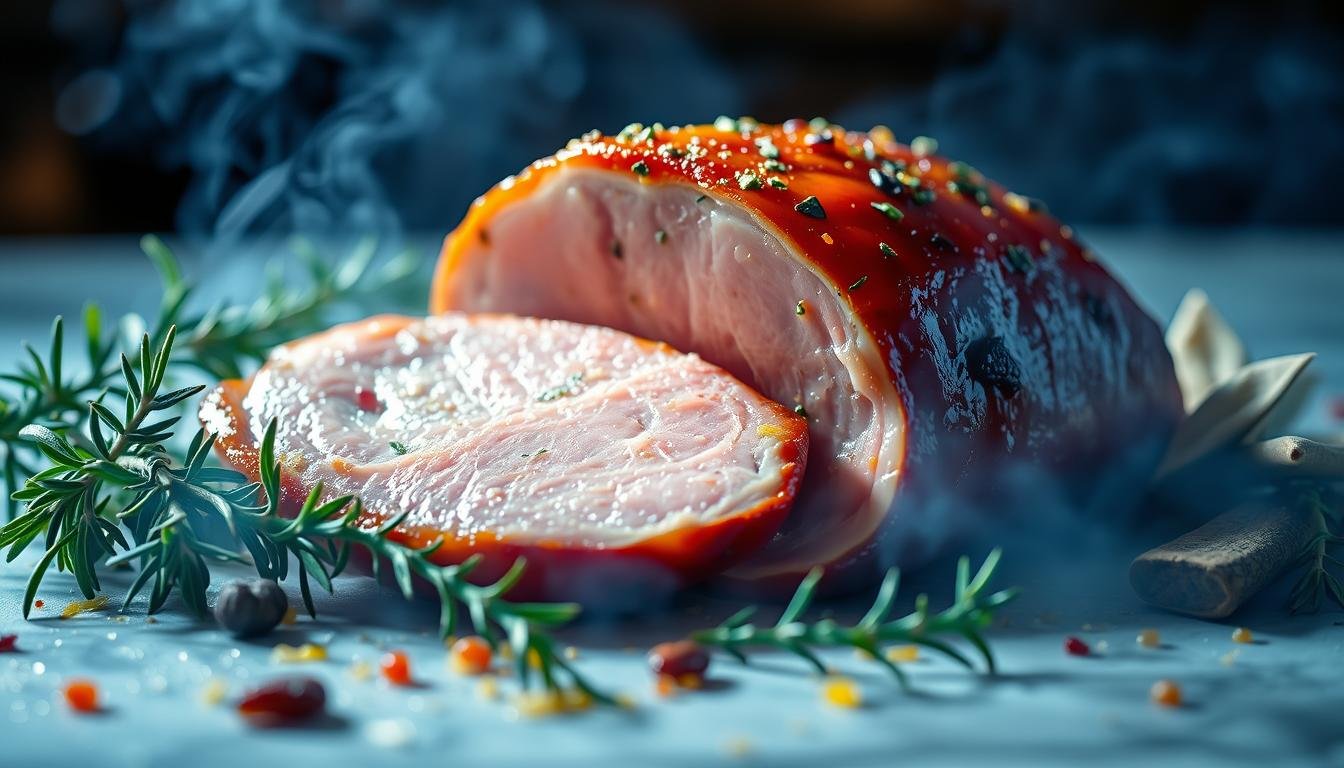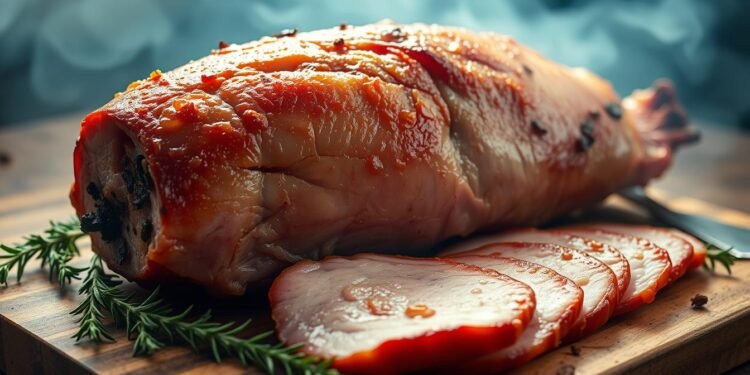It takes a mere 25 minutes per 500g to transform what was once reserved for holiday feasts into an everyday delight with our oven-baked gammon. I’m here to guide you through the no-boil gammon cooking method, which promises a succulent ham roast without the toil of traditional preparations. As an eloquent author of the editorial team at CSAC.org.uk, I will take you on a gastronomic journey that celebrates simple yet effective culinary techniques.
Foregoing the customary boiling, this approach to easy gammon recipes utilises the consistent heat of an oven to produce a roast that is both juicy and brimming with flavour. Indeed, a typical supermarket gammon joint, weighing around 750 grams, emerges from the oven not only as an aromatic centrepiece but also an economical and convenient option for leftovers and cold platters alike — a true testament to the versatility of oven-roasted gammon.
And so, with a honey, chilli, dark soy sauce, and ginger marinade, we encapsulate the essence of a meal that is indulgently rich yet surprisingly easy to master. The steam, gently swelling beneath a tent of foil, marries the meat with bursting notes of the marinade. We’ll delve into how this transforms an ordinary gammon into a dish that captures the comfort of home cooking, elevated to new heights.
Embark with me, as we chart a path through succulent landscapes and uncover the secrets of crafting an oven-roasted gammon that demands no boiling, yet yields an exquisitely tender and flavourful experience. It’s time we reimagine tradition, one delicious slice at a time.
Introduction: The Benefits of Oven-Baking Gammon
The allure of a well-prepared gammon joint lies not just in its festive appeal but also in the culinary techniques employed to maximize its flavour and tenderness. Opting for oven-baking, specifically efficient gammon roasting, leverages the meat’s natural juices, enhancing overall flavour without the need for boiling. This method strengthens the merits of flavourful gammon preparation, turning a simple meal into a mouth-watering highlight of any dining occasion.
Using efficient gammon roasting techniques, the cooking process respects the integrity of the meat, allowing it to cook evenly and retain all its succulent juices. The direct heat of the oven caramelises the outer layer of the gammon, providing a delicious contrast to the tender, moist interior. This not only ensures a flavourful gammon preparation but also enriches the gastronomic experience with every bite.
Roasting gammon benefits from precise temperature control, which is crucial for avoiding overcooking. Gammon culinary techniques include scoring the skin before roasting and basting the meat periodically with its own juices or a specially prepared glaze. These steps contribute to a superior texture and a richer flavour profile, distinguishing it from pre-packaged alternatives available in supermarkets.
Moreover, roasting is an economically efficient method of cooking large cuts of meat like gammon. It requires minimal equipment – a roasting tin and an oven are all that is needed. The process is relatively hands-off, allowing hosts to focus on preparing side dishes or entertaining guests, making it an ideal technique for both special occasions and regular family meals.
The tangible benefits of oven-baking gammon are evident in the end product: a gammon joint that is both visually appealing and delightfully flavoursome. By adhering to a few key gammon culinary techniques, even a novice cook can serve up a dish that stands out in both texture and taste, proving that the roasting gammon benefits go beyond mere convenience to deliver a truly exceptional dining experience.
Choosing Your Gammon: Smoked or Unsmoked?
When you’re at the market or butcher, choosing the right type of gammon can be crucial for your cooking and tasting experience. Both smoked and unsmoked gammon have their unique flavours, and understanding these distinctions will enhance your ability to select the best option for your culinary needs. This discussion is part of a robust gammon buying guide, aimed at helping you procure quality gammon joints for your festive dinners or Sunday roasts.
Understanding the Differences
Smoked gammon is treated over burning wood chips after being cured, infusing the meat with a robust, smoky flavour that stands out in many traditional dishes. The type of wood used for smoking can vary, with options like hickory or applewood, enhancing the gammon with subtle differences in taste. This enriched flavour profile typically appeals to those who enjoy a heartier meat experience.
On the other hand, unsmoked gammon retains the pure taste of the pork, as it’s only cured in salt and not exposed to any smoke. This variety offers a subtler, more delicate flavour, suitable for those who appreciate the natural tastes of the meat or for recipes that require a milder taste base.
What to Look for When Buying Gammon
Selecting gammon entails more than just choosing between smoked vs unsmoked gammon; it’s about identifying quality gammon joints that will provide the best eating experience. Always look for fresh meat with a firm texture and a consistent pink colour, void of any dullness or brown spots. The fat should be creamy white and not too thick. If overly salty, consider soaking the gammon in water prior to cooking to remove some of the saltiness.
Always enquire about the source of the gammon; locally sourced meat generally ensures better quality and freshness. Additionally, consider the preparation method that suits your taste preferences and the type of dish you are planning.
Using this smoke vs unsmoked gammon buying guide, you can make an informed decision on which type to select based on your flavour preference and cooking method. Whether you choose smoked or unsmoked, quality gammon joints can elevate your cooking, imparting delicious flavours to your meals.
How to Cook a Gammon Joint in the Oven Without Boiling
Mastering the gammon oven technique is essential for those who prefer a straightforward, fuss-free approach to preparing their festive or Sunday roast. The key to a delicious cooking gammon roast lies in the preparation and oven management. Here’s how you can achieve a succulent gammon joint using an oven-only method, infused with flavours that will delight your palate.

This oven method eliminates the need for boiling, making it one of the most straightforward gammon recipes. Begin by preheating your oven to 200°C (400°F). While the oven heats, massage your gammon with a homemade glaze consisting of honey, chilli, ginger, and soy sauce to create a rich, caramelised exterior. The combination of these ingredients not only adds depth to the flavour but also ensures the meat remains moist and tender.
Cover the gammon tightly with foil to trap the steam, as this helps in cooking the gammon evenly and retaining its natural juices. For a typical gammon joint, plan your cooking time around 30 minutes per 500g, adjusting slightly depending on the size of your roast. A pivotal step is basting the gammon half-way through the cooking process with its own juices, enhancing the moisture and flavour.
Once cooked, it’s crucial to allow the gammon to rest in its cooking dish for about 30 minutes before slicing. This resting period lets the juices redistribute, ensuring every slice is as delicious as the next. Always check that the internal temperature reaches at least 68°C (155°F) to confirm that it’s perfectly cooked.
The following table summarises the nutritional benefits and cooking details for a standard serving of oven-cooked gammon, making it easier to incorporate this dish into a balanced dietary plan:
| Nutrient | Amount per Serving | % Daily Value |
|---|---|---|
| Calories | 267 kcal | – |
| Total Fat | 7g | 11% |
| Saturated Fat | 2g | 13% |
| Cholesterol | 124mg | 41% |
| Sodium | 1580mg | 69% |
| Protein | 44g | 88% |
| Carbohydrates | 4g | 1% |
| Sugars | 3g | 3% |
| Iron | 1mg | 6% |
Embracing this gammon oven technique not only simplifies your cooking process but also turns your kitchen into a haven of aromas, guaranteeing a mouth-watering gammon roast that’s both nutritious and satisfying.
Preparing Your Gammon for the Oven
Effective gammon joint preparation starts well before the oven is turned on. Achieving the perfect blend of flavour and texture involves a few critical steps, such as scoring gammon skin and employing marinade recipes for gammon. These efforts ensure that every slice of gammon not only tastes delightful but also presents beautifully on your dinner table.
Scoring and Seasoning Tips
Scoring the skin of the gammon is more than just making your joint look appealing. It allows heat and flavour to penetrate deeper into the meat. Use a sharp knife to make diagonal cuts across the fat layer, creating a diamond pattern. This method is crucial for more than aesthetics; it helps the fat render down during cooking, resulting in crisped edges and a succulent interior. After scoring, liberally apply seasonings such as salt, pepper, and prepared English mustard, ensuring it seeps into the incisions for optimal gammon flavour enhancements.
Adding Flavour with Marinades and Rubs
To infuse your gammon with robust flavours, consider using a marinade. A well-composed marinade for gammon typically includes ingredients like honey, chili, ginger, and soy sauce, which not only tenderise but also enrich the meat with vibrant tastes. Here’s a simple yet effective marinade recipe:
- 2 tablespoons of honey
- 2 tablespoons of wholegrain mustard
- 1 teaspoon of apple cider vinegar
- 1 teaspoon of brown sugar
- Generous pinch of ground ginger and chili flakes
Mix these ingredients well and slather over the gammon joint, especially within the scored areas. Allow the gamon to marinate for at least several hours, or ideally overnight, to maximise the flavour absorption.

Here’s a quick guide on creating a perfectly flavoured gammon using these prep tips:
| Preparation Step | Details | Recommended Time/Amount |
|---|---|---|
| Scoring the Gammon | Make diagonal cuts on the fat | Depth of 1-2mm |
| Applying Mustard | Brush generously over and into scores | 3 heaped tablespoons |
| Adding Marinade | Use honey, mustard, vinegar mix | Ensure thorough coating |
| Resting with Marinade | Allow flavours to infuse | Minimum 12 hours |
By meticulously following these gammon joint preparation guidelines, you’ll enhance every aspect of your meal, from flavour to presentation. The combination of scoring, marinating, and proper seasoning is the secret to a memorable and delicious oven-baked gammon.
Cooking Times and Temperatures for Perfect Oven-Baked Gammon
Mastering the art of oven-baked gammon involves not just slathering the meat in rich glazes, but also adhering to accurate gammon cooking times and maintaining the ideal oven temperatures for gammon. For a standard gammon joint, such as a 750 grams cut, the recommended cooking procedure requires approximately 50 minutes in the oven, calculated as 20 minutes per 450 grams plus an additional 20 minutes to ensure thorough cooking.
To achieve the ideal cooking conditions for gammon, preheat your oven to 200°C (400°F). This oven temperature for gammon helps to perfectly caramelise the outer layer of the meat, enhancing its smoky-sweet flavour profile. Wrapping the joint in foil for the majority of the cooking time allows the gammon to cook gently, retaining its moisture and taste. Around the 50-minute mark, remove the foil and baste the gammon with its juices. This step is crucial for a succulent finish.
Monitoring the internal temperature of the gammon is equally essential. An ideal internal reading of 68°C (155°F) indicates that the meat is cooked perfectly, safeguarding against any potential food safety issues. Below, you’ll find a comprehensive table detailing not just cooking times and temperatures, but also other pertinent nutritional information to help plan your meal effectively.
| Cooking Detail | Value |
|---|---|
| Total Cooking Time for 750 grams Gammon | 50 minutes |
| Recommended Internal Temperature | 68°C (155°F) |
| Calories per Serving | 224 kcal |
| Protein per Serving | 37.7 g |
| Fat per Serving | 2 g |
| Sodium per Serving | 827 mg |
| Sugar per Serving | 7.4 g |
Following these guidelines will help ensure that your gammon is not only delectably juicy but also cooked with the precision that fine dining demands. Whether a festive occasion or a cosy Sunday roast, these tips guarantee your oven-baked gammon is a mouth-watering centrepiece.
Serving Suggestions: Accompaniments and Wine Pairings
Enhancing your oven-baked gammon with suitable sides for gammon and a thoughtful selection of wine pairings for ham can transform a simple meal into a festive feast. Here, we explore a variety of garnishes that not only complement the flavours of gammon but also elevate the overall dining experience.
Ideal Side Dishes
When it comes to crafting the perfect gammon meal composition, the sides you choose are crucial. From the velvety texture of mashed cauliflower, beloved for its health benefits, to the sweet and savoury notes of maple-miso glazed melting sweet potatoes, each side dish plays a pivotal role. The popularity of certain recipes, such as crispy domino potatoes and homemade mac and cheese, underscores their appeal at any dining table, providing both comfort and a touch of luxury.
| Side Dish | Description | Consumer Preference |
|---|---|---|
| Potatoes au Gratin | Rich, creamy and topped with a crisp crust. | 78% prefer upgraded versions. |
| Mashed Cauliflower | A low-carb alternative to traditional mashed potatoes. | 60% seek healthier options. |
| Homemade Mac and Cheese | Creamy, cheesy, with a golden topping. | 82% family favourite. |
| Crispy Domino Potatoes | Thinly sliced potatoes with crispy edges and creamy centres. | 68% favor the texture contrast. |
Complementing Your Gammon with the Right Wine
Choosing the right wine pairings for ham will not only enhance the flavour of the meat but can also bring out the subtleties and spice notes in both the marinade and garnishes. A medium-bodied Chardonnay or a crisp Riesling works beautifully to cut through the richness of the gammon. For those who might prefer red wine, a light Pinot Noir can be a delightful accompaniment, offering a fruity balance to the saltiness of the ham.
Remember, the success of a meal often lies in the harmony of its components. Whether it’s the soft crumble of blue cheese in a fig salad that accompanies your gammon, or the luscious sweetness of a maple bourbon glaze, the right gammon serving ideas and wine pairings are paramount in delivering an unforgettable dining experience.
Conclusion
In the pursuit of crafting a memorable gammon meal, the oven-baked, no-boil technique stands out as a remarkably efficient method that assures both flavour and tenderness. With a modest prep time of 5 minutes and a total cooking time of 2 hours and 35 minutes for a 2 kg gammon, this innovative gammon cooking approach has redefined kitchen simplicity. The versatility of the gammon is celebrated through a variety of glazes and seasonings that comprise ingredients such as honey, mustard, and fresh ginger, infusing the meat with an exquisite depth of flavour.
The instructions detailed within this article offer a stress-free gammon dish experience tailored to both intimate family gatherings and grand festive celebrations. Serving suggestions have been provided, ensuring that the gammon’s succulent texture is complemented by both classical and contemporary sides. The subsequent pairing with a meticulously selected wine is the pièce de résistance that elevates your dining occasion to an unforgettable culinary highlight.
Finally, beyond mere indulgence at the table, this method extends the appeal of gammon by presenting a sustainable option that minimises waste. Leftovers, safely stored for later consumption, inspire further innovative culinary endeavours, be it through chilled dishes or reimagined comfort food classics. Whether served hot or enjoyed cold, the result of the oven-baked technique is a testament to the gammon joint’s adaptability to various tastes and preparations, ensuring each meal is not only a feast for the palate but also an expression of culinary creativity.












